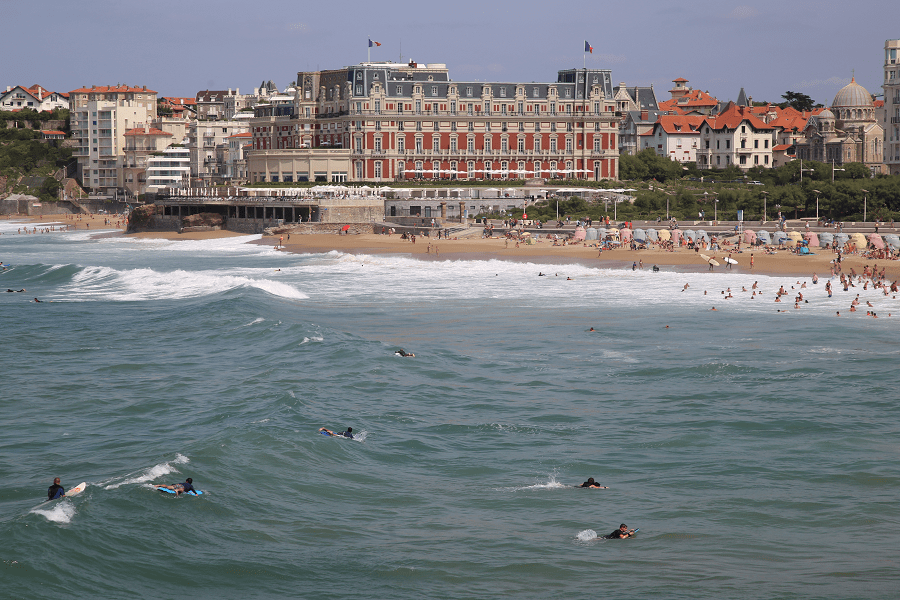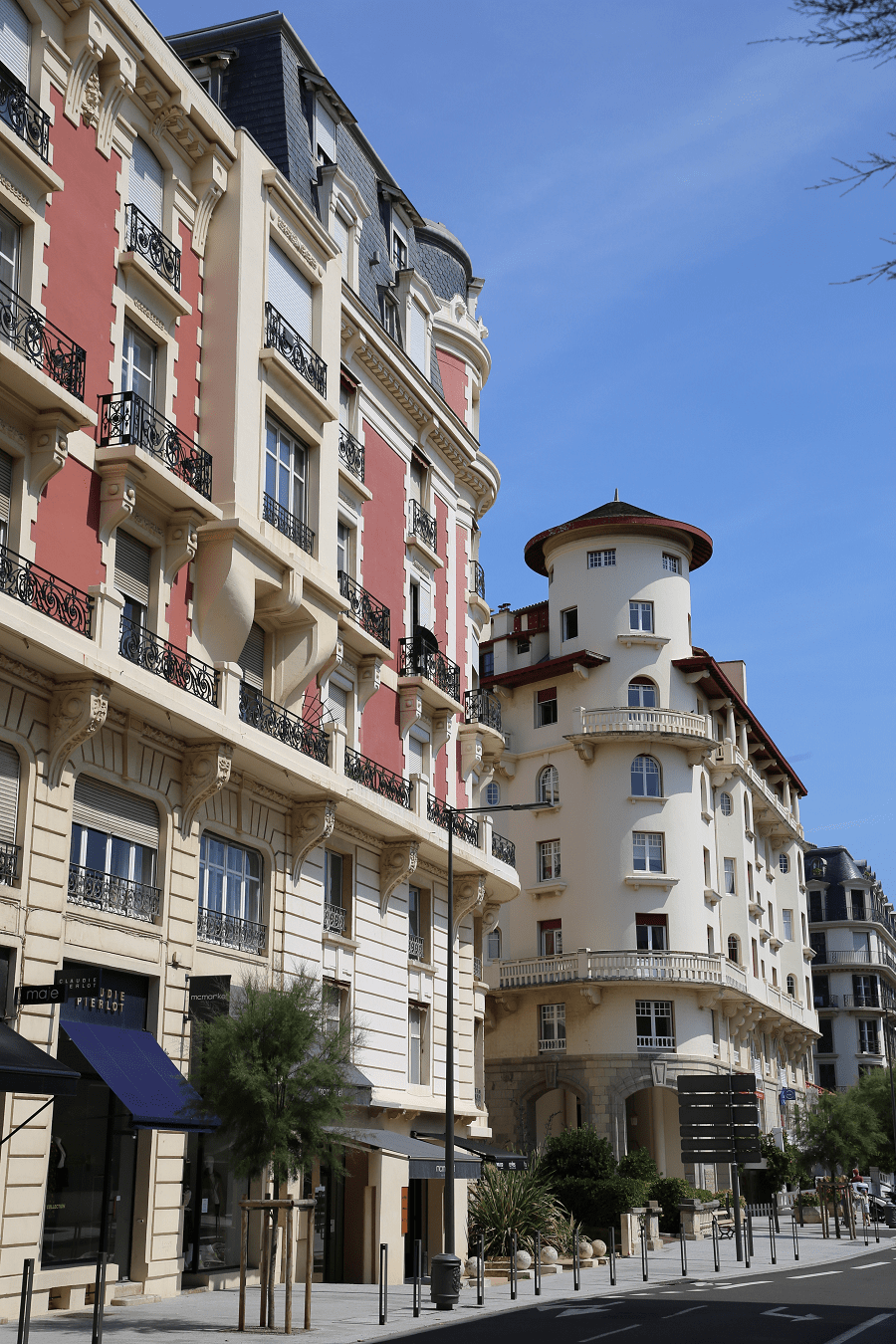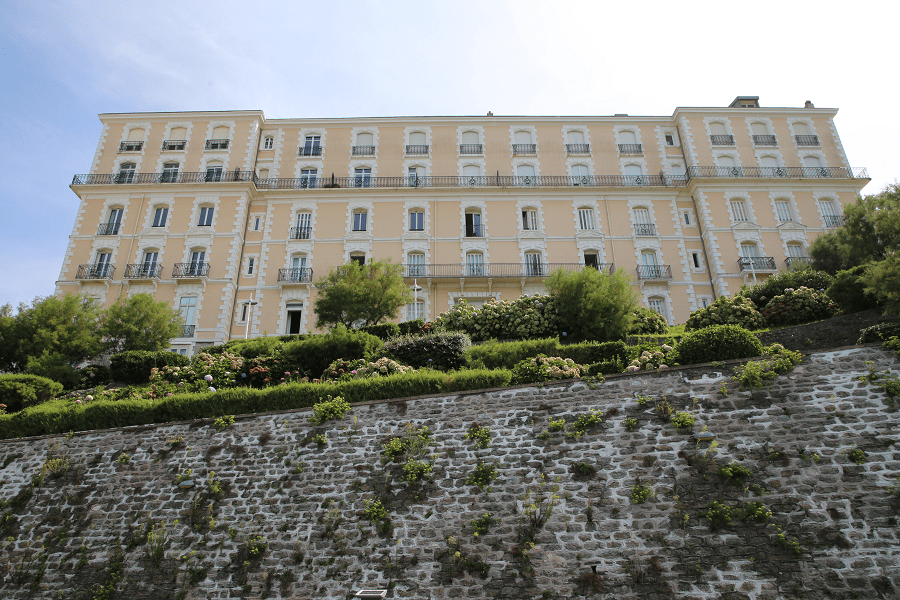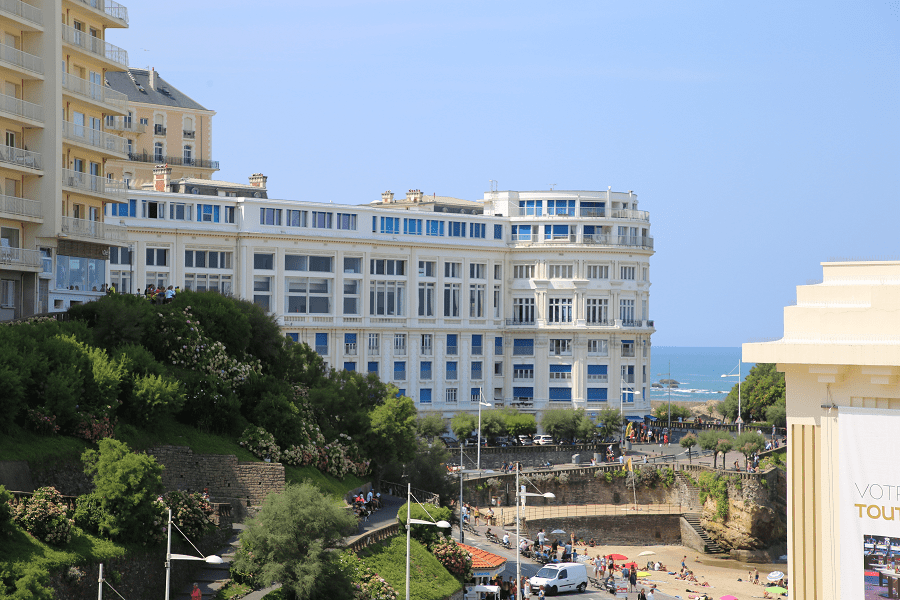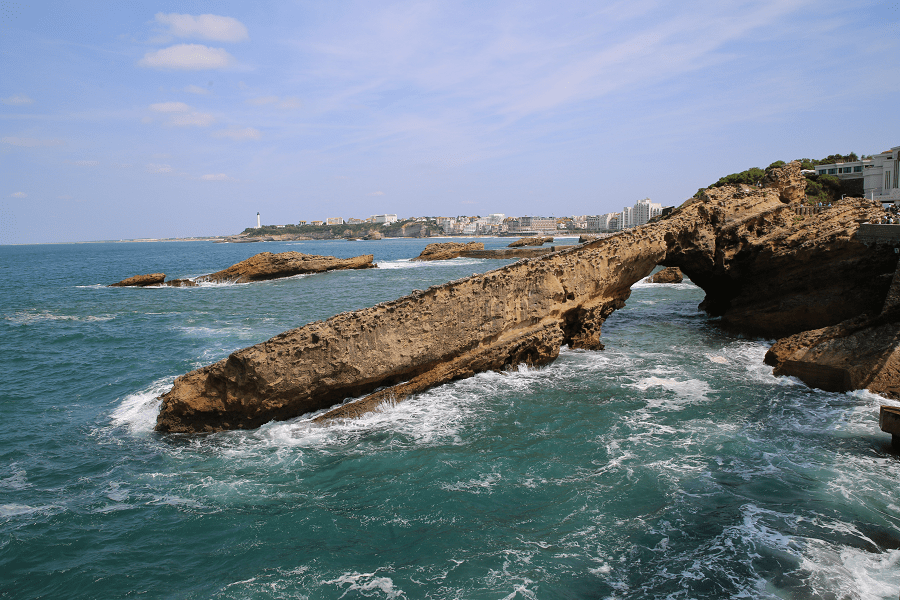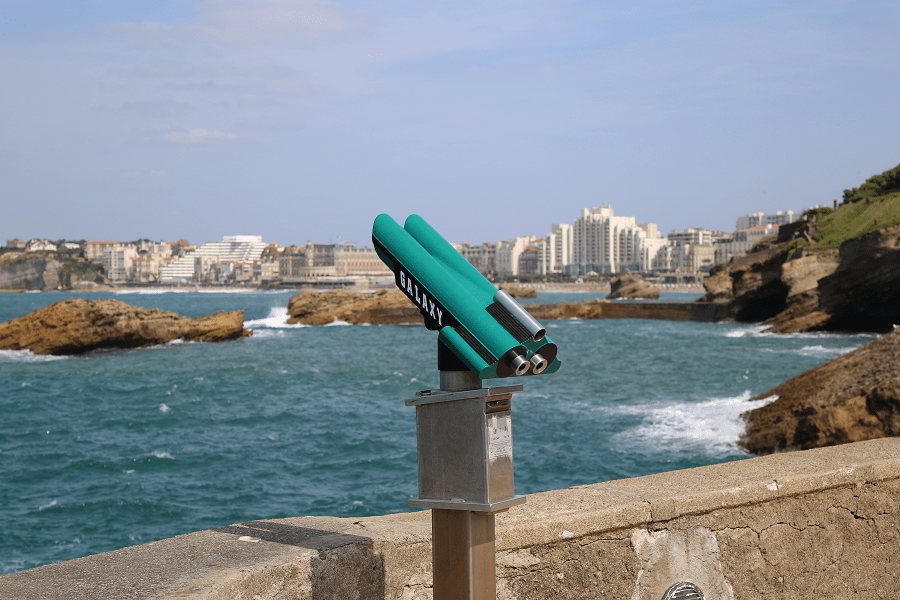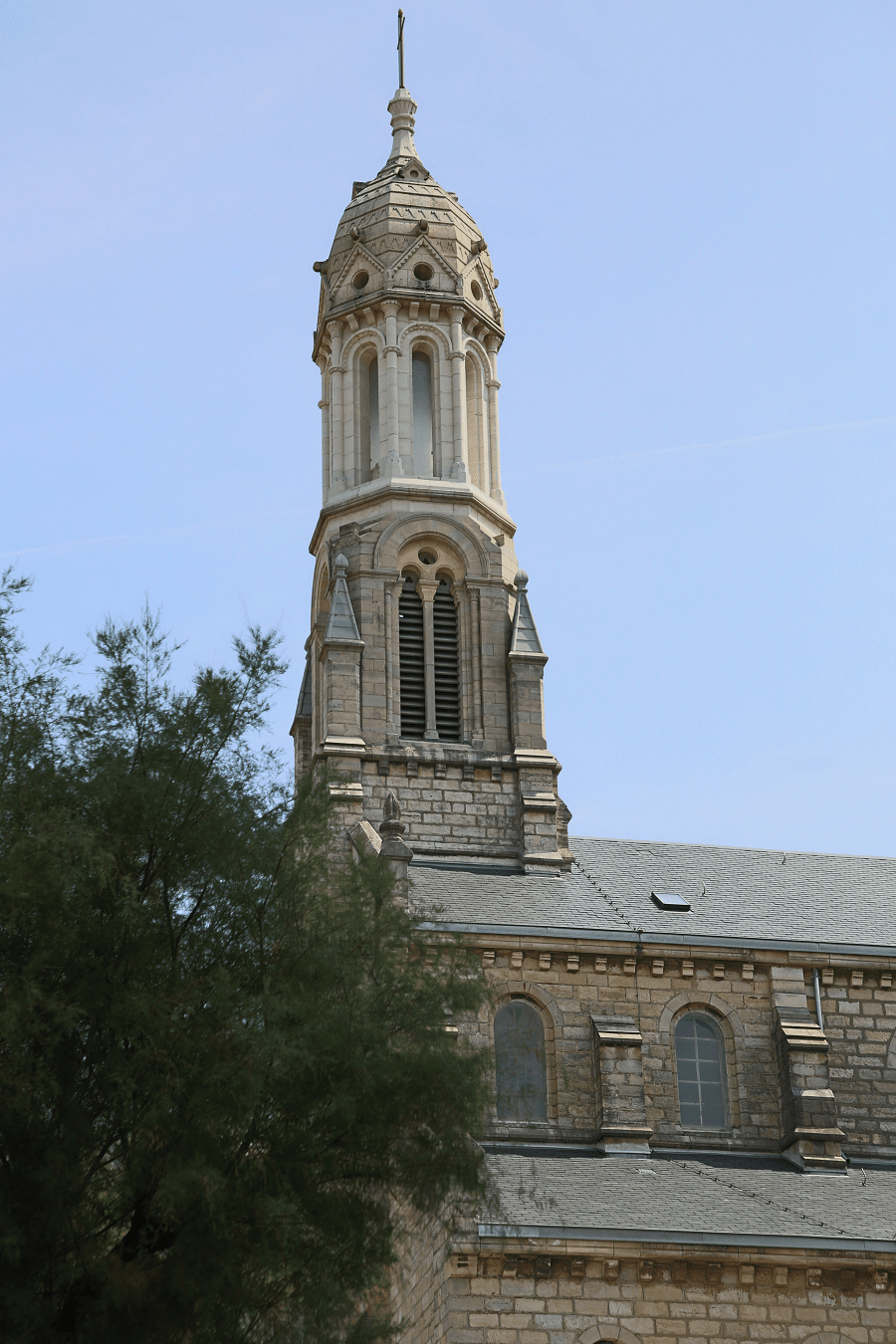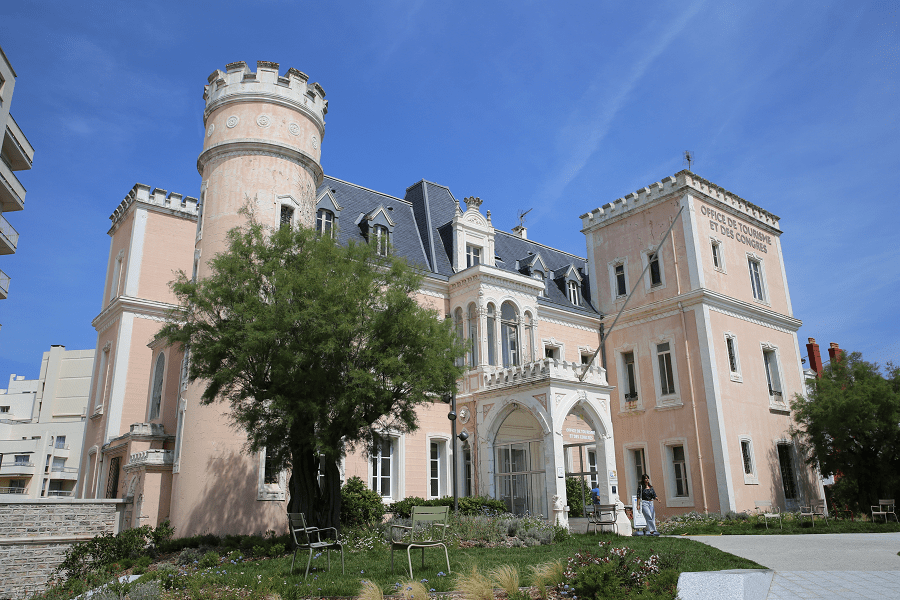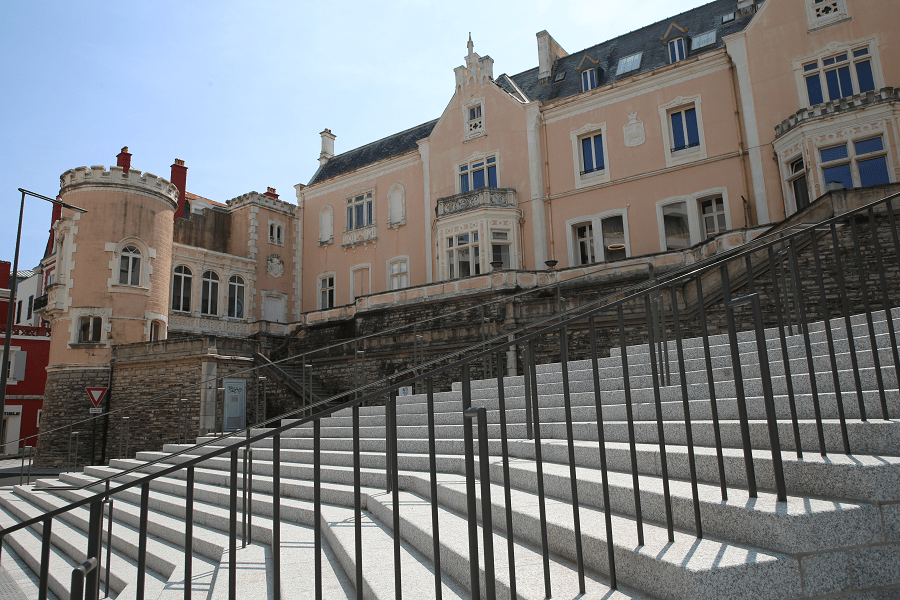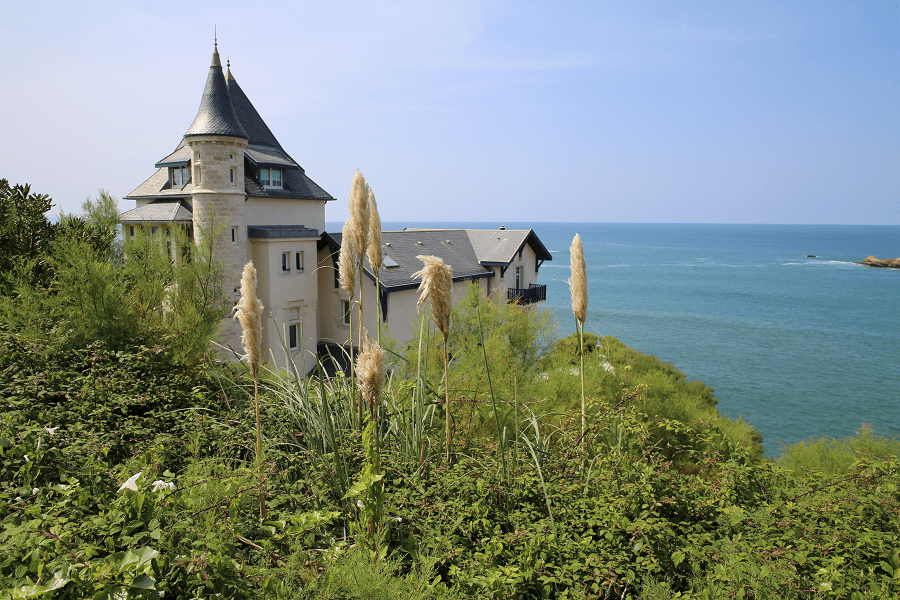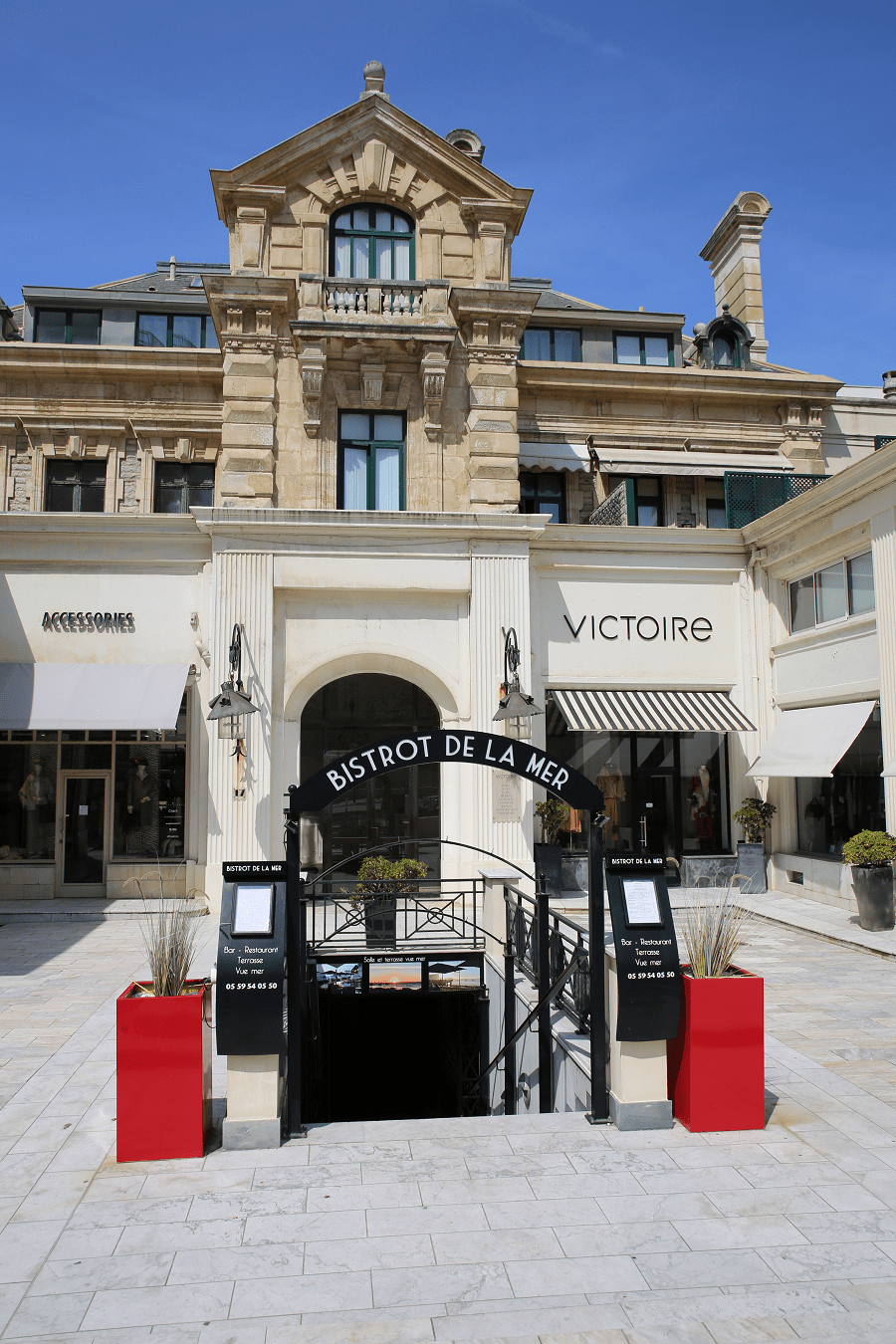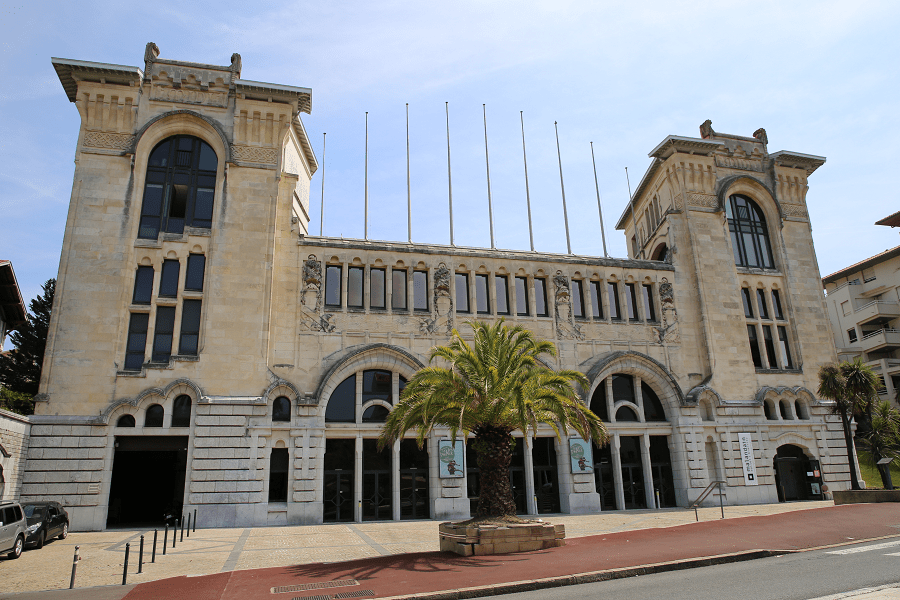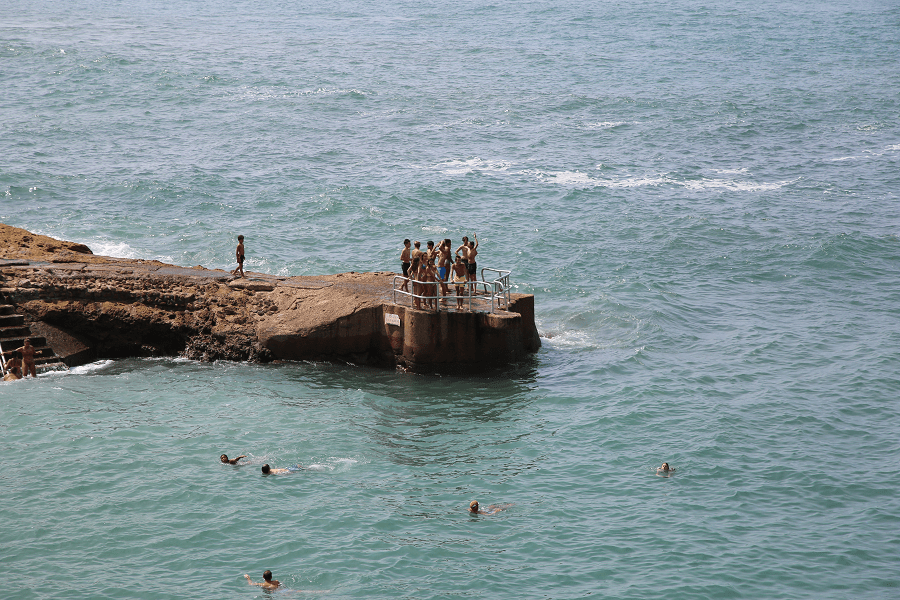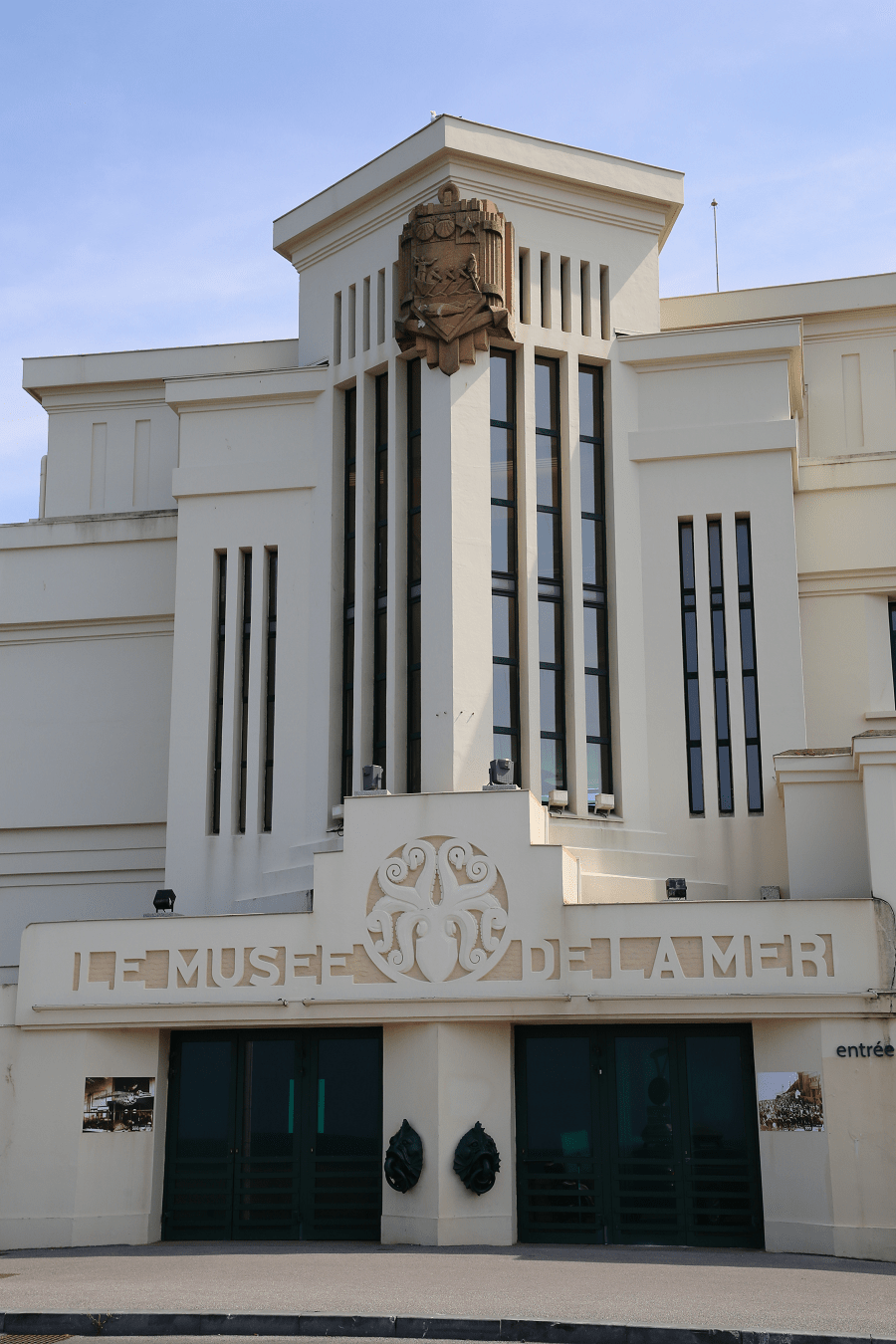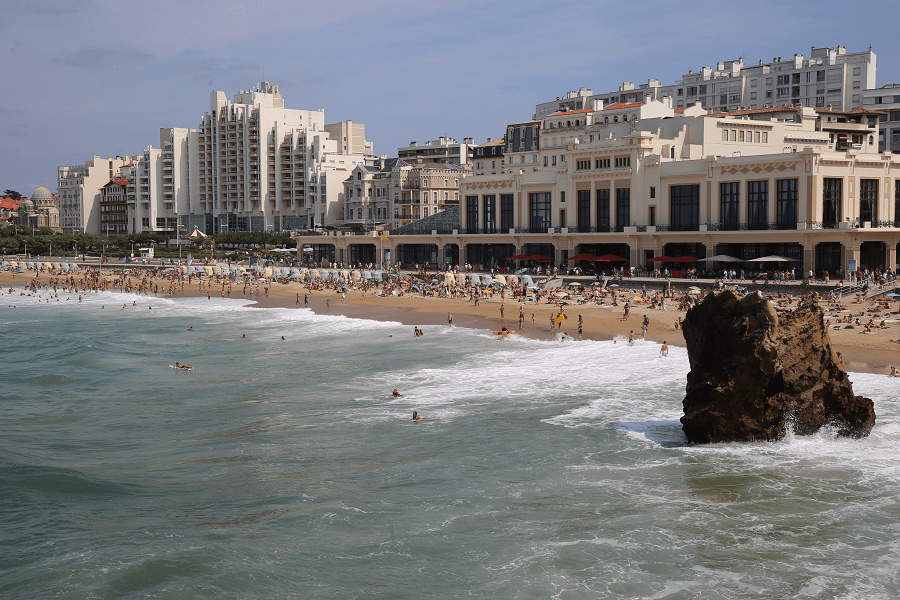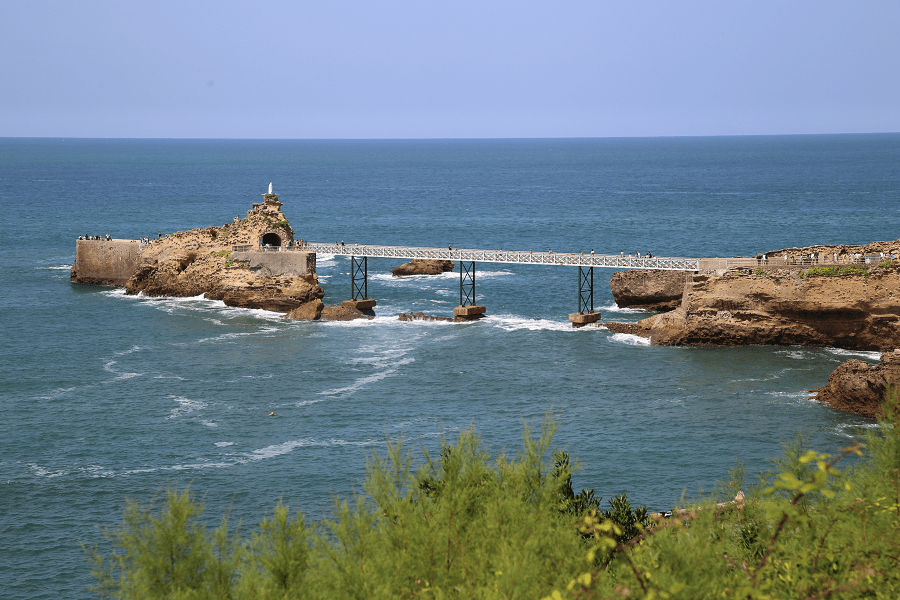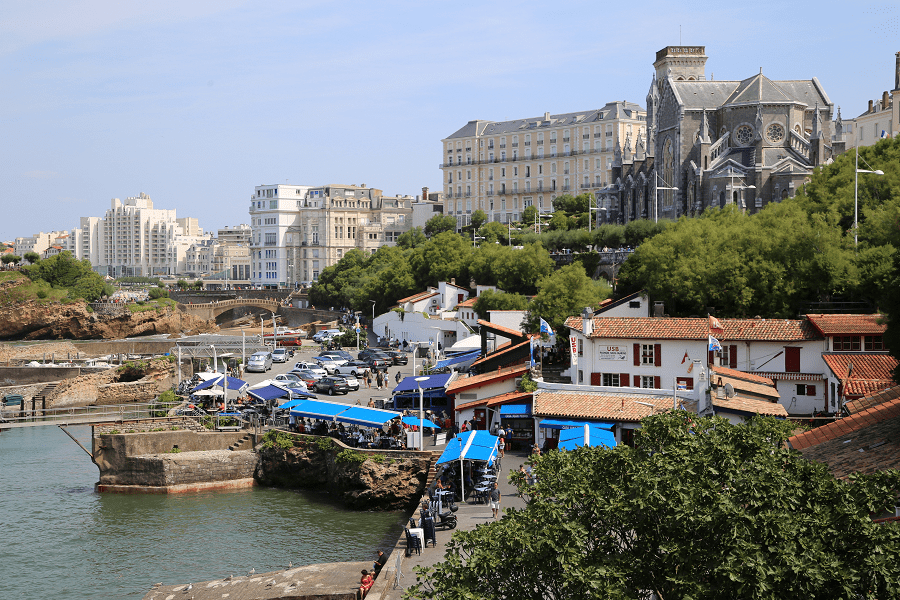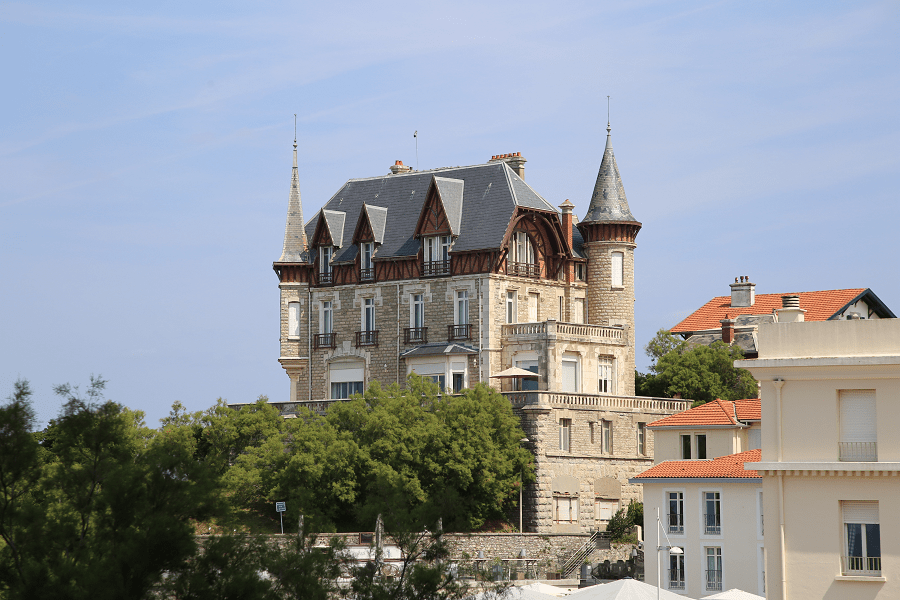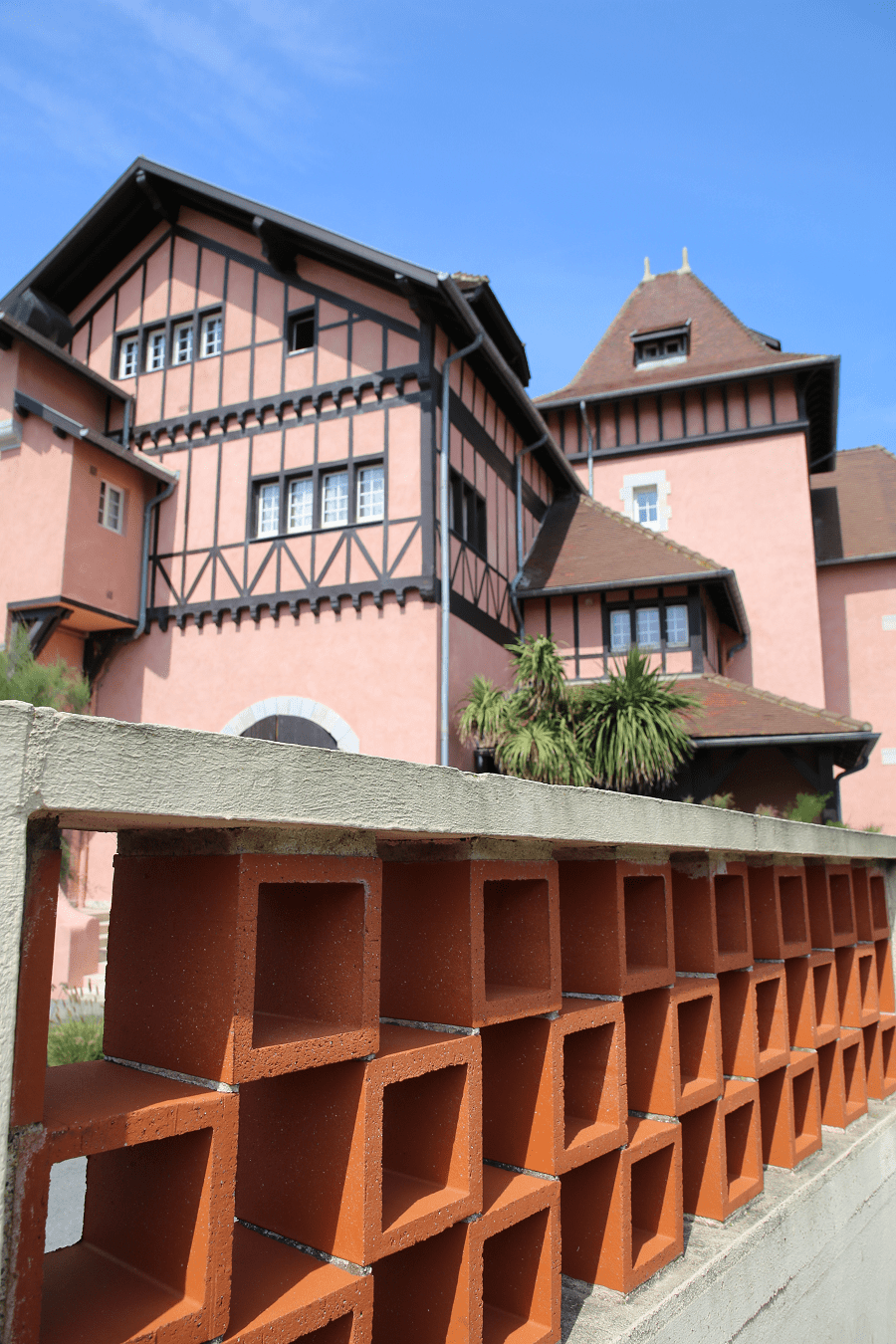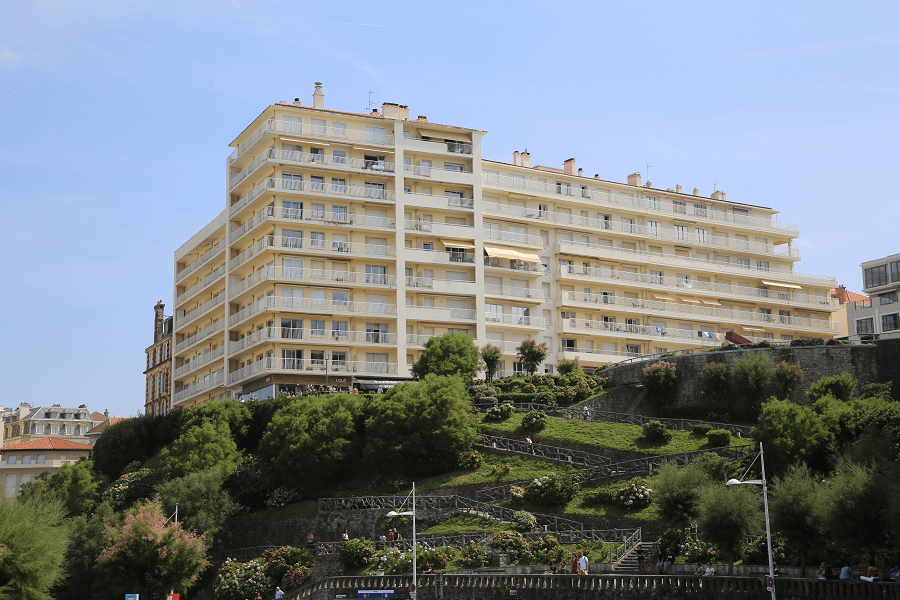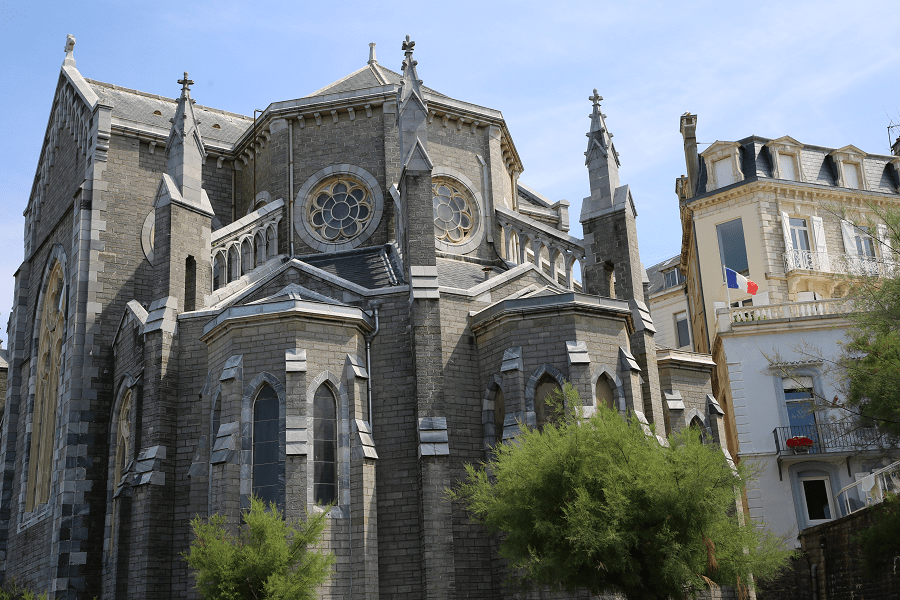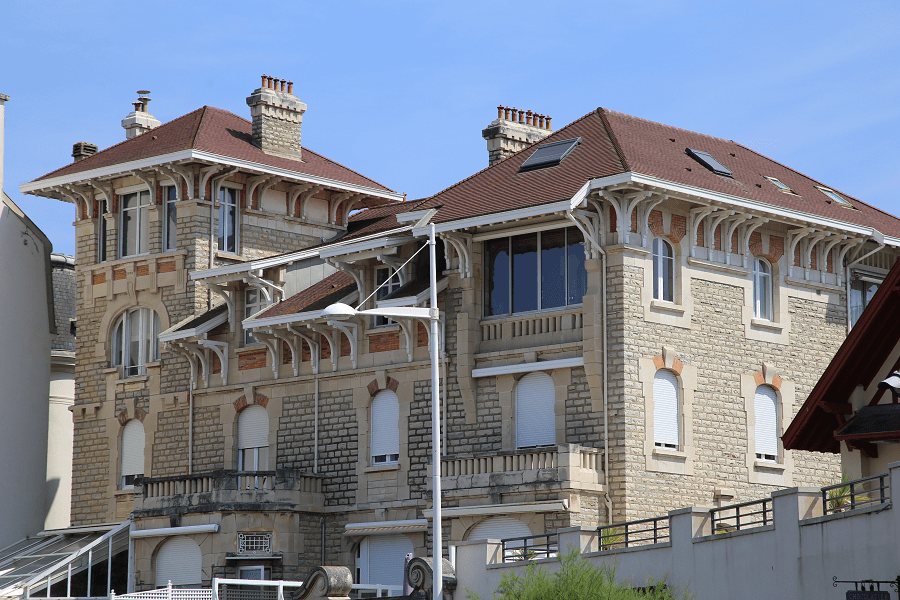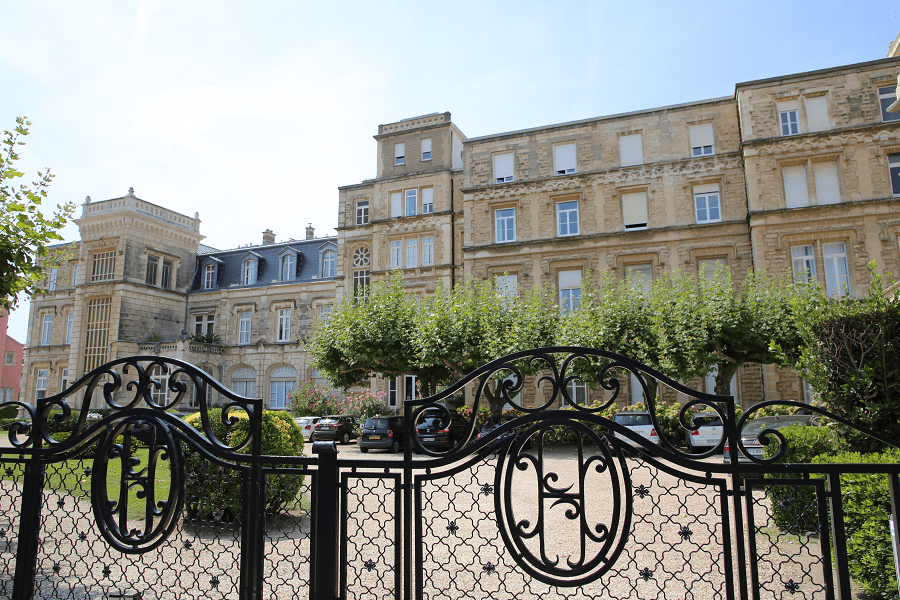Biarritz (fr. Biarritz) – a luxury resort town belonging to the Atlantic Pyrenees Department (Pyrénées-Atlantiques), the New Aquitaine Region in southwestern France. Its current Basque name is Biarritz (or Miarritze), and its current Gascon name is Biàrrits.
It is also one of the major French seaside resorts on the Atlantic coast, alongside Arcachon, Royan, Les Sables-d’Olonne and La Baule-Escoublac.
The name Biarritz probably comes from the berarr Basque root, replacing belharr, “grass” with the suffix -itz addition and its “grassy place” meaning. This is entirely plausible, since Biarritz was only a village in a swamp back in the nineteenth century.
Bordered by the Atlantic Ocean, the city has a coastline of four kilometers in the Bay of Biscay valley, less than 25 kilometers from the border with Spain. Biarritz is located on the border between the Basque lands and Gascony.
Therefore, there are Basque Country red-green-white flags next to the French and European Union flags on all administrative buildings of the department.
The city was formed as a result of the merger of two suburban areas of the neighboring city of Bayonne, one of which was engaged in agriculture, and the other in marine industries. It was here that the first whaling port of France was located.
Biarritz became a separate city presumably at the end of the sixteenth century or the beginning of the seventeenth century. However, it is part of the Basque Labourd province and is part of the Bayonne urban area (l’aire urbaine).
Saint-Martin Cape, above which the Biarritz lighthouse rises, is the border between the sandy beaches of the Silver Coast in the north, starting in the Gironde area and ending in Anglet, and the rocky coast of the Basque Country in the south.
There are three sandy beaches within the city: the Grand Beach (Grande Plage), the Basque coast (la côte des Basques), and the Old Port (le port-vieux).
Biarritz experienced severe economic upheaval in the nineteenth century. It was then that Empress Eugenia (María Eugenia Ignacia Agustina de Palafox y Kirkpatrick, Spanish by birth, wife of Napoleon III, Emperor of France from January 29th, 1853 to September 4th, 1870) decided to turn the city into a resort. Bathing became popular in the city, and the European aristocracy went here.
The resort development continued during the Belle Epoque, a period that is a retrospective chrononym of the social, economic, technological and political progress times in France and Belgium, from the end of the 19th century until the outbreak of World War I in 1914. Since then, the main source of income for the city is resort activities, its luxury hotels and restaurants.
Biarritz today is a city with a population of about 25,000 people with a high proportion of older people. The Biarritz Town Hall divides the city into six quarters in which the district municipalities operate.
The city is also famous for the fact that famous French athletes were born and lived in it. Among them are Jean Laurent Robert Borotra, the French tennis player and politician, known as the “bouncing basque”, Joel de Rosnay, surfer and scientist, Serge Blanco, who was called rugby “Pele”.
The mild climate, powerful ocean waves, and the city’s eclectic architecture inspired many writers to create their works.
Geological features
Biarritz is located on a specific geological site; the landez coast (la côte landaise), which extends to Anglet (Anglet) and represents 200 km of straight and low sandy waterside, forming dunes. However, the Basque coast is much more indented by cliffs, starting from Biarritz. On 4 km of the city’s coast, three sedimentary tiers replace each other.
There are steep cliffs from Chambre d’Amour to la plage Miramar; they formed simultaneously with the Pyrenees 25 million years ago. The coastline is filled with numerous rocky islets from L’hôtel du Palais to la villa Beltza. They formed 34 million years ago.
The Biarritz facade starts from north to south, from Cape Saint-Martin, continues in the large bay of Miramar and Grand beaches, and ends at the port. The Virgin Cliff (le rocher de la Vierge) is a cape from which start Old Port (Port-vieux), the Basque coast (la Côte des Basques), Marbella, and, finally, Milady beaches.
The commune area is 1,166 ha; the height ranges from 0 to 85 meters.
Climate and weather
Facing the ocean and shaped like an amphitheater, Biarritz is open to the winds. Winters are mild, and summer heat is bearable. This privileged climatic situation brought the city to the “hydrothermal and climatic station” status since 1912.
Three winds types blow here: from the Atlantic Ocean, from the Pyrenees, and local breezes. Winds bring moisture and freshness in summer and softness in winter. Warm winds from the South have the so-called “hairdryer effect”. Indeed, the air from Spain loses moisture, crossing the Pyrenees, and heats up, losing altitude.
The city is often exposed to higher temperatures in winter compared to the rest of the country. The average temperature in winter is about 8° C, and in summer is about 20 ° C. The lowest recorded temperature here was filed in 1985 (minus 12.7° C), and the highest in 2003 (plus 40.6° C). There are rare rains on the Basque coast except in winter. They appear often in intense thunderstorm form, which explains the large amount of rainfall, but the rainy days number per year is less than in some other French regions (181 days a year). There are 1887 sunny hours per year average in the city.
History
It is known that the lighthouse cave in Biarritz (la grotte du phare de Biarritz) was inhabited during the Copper Age (Chalcolithic), and then during the Late Bronze Age.
There is some small evidence of the Roman or Vasconian cultures presence in the city of Biarritz. It is unlike the neighboring city of Bayonne, which was a Roman citadel in the first century AD.
Many more facts tell about the Middle Ages. We know, for example, that in 1152 the Duchess of Aquitaine Ailénor d’Aquitaine married Henri Plantagenêt, who became overlord of the Duchy of Aquitaine. Prince Edward, eldest son of Henry III of England, vested with a duchy, was engaged to Eleanor of Castile, who brought him the rights to Gascony.
At the top of the city’s prominent cape called Atalaye, which served as a place for whale watching, the British erected a fortified castle using the foundation of an old Roman building. This castle, called Ferragus, had a double layer of fortifications; the walls were two meters thick. The castle had a drawbridge and four towers. There was the castle, mentioned in 1603 (Henry IV royal letters). In the future, only one tower remained from the castle, where in 1739, by the decision of the French Secretary of State of the Navy, they built a lighthouse, which served as a navigation landmark. They destroyed the tower in 1856.
The city led an active “marine life” at this time. A watchman was on duty day and night at Cape Atalay, scanning the horizon in search of whales and commanding the whalers, anchored in the Old Port, to go out into the ocean if they were found. They caught the last whale in 1686.
Sea baths appeared in Biarritz Since 1784, and Napoleon rested here in 1808. When Victor Hugo arrived here in 1843, he foresaw that there would be a famous resort. It was Empress Eugenia, who decided to make Biarritz her resort after she stayed there for two months in 1854. Napoleon III built a 12-story palace at her request here, which hosted the crowned heads from all of Europe. The resort became famous as the “king of beaches and beaches for kings”.
It was in Biarritz that the “iron chancellor” Bismarck met with Napoleon III in September 1865 in order to enlist the support of the French emperor in Prussian politics. Biarritz have preserved several buildings unusual for this place, among which a two-domed Orthodox Church, testifying to the popularity of Biarritz among the Russian aristocracy before the October Revolution in Russia.
Biarritz was popular among the Russian nobility at the end of the nineteenth century. The Alexander Nevsky Orthodox Temple was consecrated in the city in 1892. Feodor Chaliapin lived in his villa in Biarritz. A.P. Chekhov spent two weeks here In September 1897 at the Victoria Hotel, according to which “The most interesting thing here is the ocean; it makes noise even in very quiet weather.” Nabokov family often brought their son Volodya here. Vladimir Nabokov, who became a world famous writer, recalled being in Biarritz as living in paradise. Grand Duke Dmitry Pavlovich married American Audrey Emery in Biarritz. Prince Alexander Petrovich of Oldenburg lived in the city after the Russian revolution and emigration. Russian writer Vasily Aksyonov lived in Biarritz, as well as TV presenter Alexei Lushnikov, who shot the documentary film “The Ambassadorial Church” about Alexander Nevsky Cathedral.
The salt hydropathics opened in Biarritz during the Belle Epoque years. Architect Lagarde designed the building, Queen of Serbia Natalia Obrenovic laid the first stone in December 1892, and the grand opening took place in June 1893. They laid an underground pipeline with a length of more than 20 kilometers to supply brine from Briskus, in which the salt content was 10 times higher than the sea water salinity. They closed this hydropathic facility in 1953, and demolished the building in 1968.
The Germans used the Biarritz rocky cliffs to create the Atlantic Wall during World War II in 1940. A well-thought-out defense in Biarritz remained unclaimed, since the Allied descent did not land here.
German troops occupied the Basque coast on June 27th, 1940.
Allied Air Forces bombarded the city on March 17th, 1944; the raid second wave destroyed the Parm airfield. The Biarritz American University was located in the city after the liberation for several months, where allied forces trained.
The American screenwriter Peter Viertel, while traveling in Biarritz on the occasion of shooting a film adaptation of “The Sun Also Rises” novel, stood here on a board sent by his friend from California in 1956. This marked the beginning of surfing in Biarritz. The first international competitions took place on July 24th, 1960, and the first French championship took place on September 11th, 1960, the winner of which was Joël de Rosnay.
They created a rescue squad in parallel with training and competition, it served as a model for the future rescue service, Service d’aide médicale urgente.
The G7 summit took place here with the participation of Canada, the USA, Great Britain, France, Germany, Italy and Japan from August 24 to 26, 2019. Russia was not present due to its exclusion after the crisis in Crimea in 2014.
Tourism, sights and main attractions
Biarritz has 10 monuments on the historical monuments list and 1 monument on the cultural heritage general list. The Virgin Rock (le rocher de la Vierge) is one of the city emblems. They drilled it at the initiative of Napoleon III to create the basis for the haven harbor construction. They installed the Virgin statue in 1865; they bought it at the Franco-Spanish exhibition in Bayonne.
There was a wooden footbridge here until 1887.
Hôtel du Palais is the former villa of Empress Eugenia, wife of Napoleon III. The villa retained its original name until 1893.They rebuilt it after a fire in February 1903. Otto von Bismarck, Winston Churchill, Vladimir Putin, Coco Chanel, and Frank Sinatra stayed here. This luxury hotel now has a 5 stars rating.
Miremont Confectionery. It dated to the beginning of the nineteenth century. The King of Spain Alfonso XIII and Queen Amelia Orleans visited this place, in particular.
Municipal Casino is an Art Deco building built in 1929 by architect Alfred Laulhé.
Pointe Saint-Martin lighthouse, built from 1830 to 1832, is one of the most visible points in this part of Biscay Bay.
Villa Belza, designed by architect Alphonse Bertrand and built in 1895 for Ange du Fresna in honor of his wife Marie-Belza, stands on Cachous Rock. There was a cabaret established by Igor Stravinsky in the Roaring Twenties, which became “the incorrigible revelers last refuge.”
They built the imperial chapel in 1863 in honor of the French troops’ victory in Mexico. The chapel was dedicated to Mexico patroness, Our Lady of Guadalupe.
St. Martin’s Church dates from 1450. Her pediment used to be whitewashed every year to serve as a guide for fishermen.
Museums
Maritime Museum (Musée de la Mer) is an Art Deco building located on the Atalay Plateau cliff. It preserves the large collection of sea birds and animals. The Maritime Museum emblem is the white octopus on the blue background.
The History Museum location is next to market squares in the Saint-Andrew Church.
There is Asiatica Asian Art Museum, which collects art from India, Tibet, Nepal, and China. Museum area is 800 m2.
Music and dancing
The “Malandain Ballet Biarritz” is a national choreographic center, opened in 1998. The city of Biarritz, the Ministry of Culture, Aquitaine DRAC, and the Atlantic Pyrenees General Council provide the funding for it. It has a partnership with San Sebastian (Spain). The ballet troupe has 22 dancers.
L’Atabal is a cultural center that brings together various styles of contemporary music. Its location is in the La Négresse industrial area.
Basque refugees created the Biarritz Oldarra Basque Ballet in 1945.
Theater and animation
The imperial couple (Napoleon III and Empress Eugene) became the founder of the fashion for the maritime theater in Port-Vieux. There is a Biarritz coastline illumination every evening by Pierre Bideau project.
The city organizes street theater performances also, culminating in the Translatines Street Art Festival.
Cinema
Biarritz Film Festival shows the best movies from Latin America in all genres (feature films, short films, documentaries).
International Festival of Audiovisual Programs (FIPA, currently FIPADOC) is an annual meeting of professionals in the field of audiovisual services since 1987; its goals are new talents’ emergence and the films’ sale outside their home countries.
They choose Biarritz often as the location for many films, such as:
Hotel America (Hôtel des Amériques),1981, Andre Techene film with Catherine Deneuve and Patrick Dewaere; Deadly Circuit (Mortelle randonnée), 1983, Claude Miller film with Isabelle Adjani and Michel Serrault; The Green Ray (Le rayon vert) 1986, Eric Rohmer film where Hubert Reeves explains the green ray phenomenon in a scene located on the lighthouse embankment; My Nights Are More Beautiful Than Your Days (Mes nuits sont plus belles que vos jours), 1989, Andrzej Zulavski film with Jacques Dutronc and Sophie Marceau; Sky, Birds, and Your Mother! (Le Ciel, les Oiseaux et… ta mère !), 1998, Djamel Bensalah film with Jamel Debbouze, Olivie Bonamy, and Lorant Deutsch; Rape Me (Baise-moi) (2000, Virginie Despentes and Coralie Trinh Thi; A Good Person (Quelqu’un de bien), 2002, Patrick Timsit film with Jose Garcia; The Giraffe’s Neck (Le Cou de la giraffe), 2004, Safi Nebbou film with Sandrine Bonnaire, Claude Rich, Louisa Pili; Priceless (Hors de prix), 2006, Pierre Salvadori film with Audrey Tautou, Gad Elmaleh; Chéri (2009), Stephane Frears film with Michelle Pfeiffer
City Districts
Saint-Charles / Phare / Larochefoucauld District
Saint-Charles Quarter is located to the north from the locality and borders with Anglet. It combines many shops and various services. It unites cult places of different cultures, the Orthodox Church, the Israeli temple, and the imperial chapel. Saint Charles is the area’s patron saint.
The Phare district name is after the Biarritz Lighthouse, which opened February 1st, 1834. Rue du Phare street runs from Avenue du Golf to la rue Lasvignottes street.
Count Gaëtan de La Rochefoucauld, a politician, settled in Biarritz in 1873. He received the great people of his time on his estate, including Queen Victoria in 1889 and Princess Yurievsky in 1893.
André-Malraux Lyceum (le lycée André-Malraux) opened in the area in 1937, being originally a branch of the Bayonne Lyceum.
City Center
Clemenceau Square (la place Clemenceau) is the city center, from where the city’s main shopping streets diverge. You can stroll through the fashion boutiques of the world’s most famous fashion trendsetters in Bellevue Square (La Place Bellevue), overlooking the ocean. Port Vieux is part of this eclectic ensemble also.
République / Larrepunte / Saint-Martin / Lahouze District
The Republic district got its name from the avenue of the same name, which starts from Marshal Foch Avenue (l’avenue du Maréchal Foch) and ends at Croix-des-Champs.
Larrepunte street, which once housed the Etoile dance hall (le dancing l’Étoile), stretches from Perico street (la rue Péricot) to Reptou street (la rue du Reptou). Larrepunte is an ancient surname; Pierre de Larrepunte was Biarritz Abbot in 1598, and Martin de Larrepunte and Gratian de Larrepunte were the commune deputies in 1610 and 1642, respectively.
The Saint-Martin quarter, located on a small hill, is one of the first Biarritz settlements. Saint-Martin Church is a historical monument. The Saint-Martin parish, a former Bayonne suburb, became an independent community, freed from Bayonne control at the end of the sixteenth century. Lahouze or Lahousse family is one of the oldest city families.
Milady / Colline / Beaurivage District
The Milady Quarter name is after Lady Marie Caroline Bruce, wife of Ernest Auguste Charles, President of the Biarritz British Club for over a decade. She was also a friend of Napoleon III, who sometimes stayed at the Villa Marbella, built in 1863 by Lady Bruce.
The Colline quarter consists of the same name street, which starts from Avenue Milady (l’avenue de la Milady) and ends on Cristobal Street (la rue de Cristobal).
The Beaurivage quarter has access to the Basque coast and is traditionally a place popular with both sailors and tourists.
La Négresse Quarter
The quarter’s previous name was Harausta. La Négresse is a residential area today grouped around the train station. The railway stretched to Biarritz (Biarritz La Negress station) in 1862 from Bayonne. This quarter houses the buildings of Victor Duruy Elementary School, Villa Fal College, Biarritz Atlantique Lyceum (le lycée hôtelier et de tourisme Biarritz-Atlantique), as well as Sainte-Thérèse Parish Church.
Braou / Ranquine / Aguiléra District
This is a residential quarters’ district with old Basque-style buildings. Le rond-point de l’Europe Interchange is one of the main traffic junctions connecting Biarritz with the north of the department. Braou (Lou Braou) is the name of the house, built in the eighteenth century. There is now the eponymous elementary school in Braou quarter.
Ranquine is the farm name in Biarritz, first mentioned in 1863. There is a cemetery in this area, where, in particular, the French singer and musician Daniel Balavoine is buried. A waste disposal center is located in the area also.
Aguiléra is the surname of the former owner of a huge piece of land (Don José Aguilera y Chapin), which the city bought in 1906. MB 12. The area has a multi-purpose stadium that can accommodate 15,000 people today. The current usage is primarily for rugby matches and is the home stadium of Biarritz Olympic. Here is the Biarritz Olympic Basque Country Rugby Club.
Shopping
Shopping lovers will appreciate this city. The most famous trendsetters’ boutiques are in the center of Biarritz. Coco Chanel, French couturier of British descent, one of the founders of Parisian high fashion Charles Frederick Worth, predecessor of art deco style, creator of the famous fashion house Paul Poiret, French couturier and perfume maker Jean Patou, founder of the oldest fashion house in Paris, Jeanne Lanvin, British fashion designer and perfumer Edward Molyneux, and French-born Belgian and German fashion designer Maggy Rouff are among them.
Restaurants
Gourmet Restaurants: Le Bistrot Gourmet, L’Impertinent, Chez Scott, La Crique.
Local cuisine restaurants: L’Entre Deux, A La Bonne Franquette, LTB La Table Basque, La Cabane A Huitres
Reasonably priced restaurants: Locadillos, La Grappe à Fromages, La Humade, Fumoir Marin
Tasty and inexpensive: A La Bonne Franquette, Biarritz Pizza, Le Glouby, Dino Pizza.
How to get there?
By car:
There is the toll road A64 from Toulouse to Biarritz. There is the toll road A63 from Bordeaux to Biarritz. The same road goes from Biarritz to the French border and further to Bilbao and Madrid.
Distances by car:
From Nantes (tolls): 5 h 10 min (545 km) via A83, A10 and A63
From Bordeaux (tolls): 2 h 13 min (198 km) via A63
From Toulouse (tolls): 3 h 3 min (308 km) via A64
From Monaco (tolls): 8 h 10 min (884 km) via A64
From Nice (tolls): 7 h 59 min (862 km) via A64
From Marseille (tolls): 6 h 32 min (705 km) via A64
From Perpignan (tolls): 4 h 42 min (508 km) via A61 and A64
From Andorra (tolls): 5 h 1 min (415 km) via A64
By railroad
The Biarritz railway station is at the city south western part. High speed TGV trains go to Biarritz.
There was Biarritz connection with Bayonne from 1888 to 1948 by three tram routes a meter gauge.
By plane
Biarriz-Anglet-Bayonne airport services Biarrits; its location is on Anglet and Biarritz communes’ territory.
Municipal transport
Biarritz is served by 10 routes (some work only at night, some only in the summer months) of the Chronoplus bus network, which connects the city with other communes of the metropolitan area: Anglet, Bayonne, Bidar, Boucau, Saint-Pierre-d’Iroub, and Tarnos.
Main information
Area: 11.4 sq. km
Coordinates: 43°29′N 1°34′W
Population: 25,402 (2019)
Languages: French, Basque
Currency: Euro
Visa: Schengen
Time: Central European UTC +1
See here best sea and ocean resorts of France and Spain (223 objects)



